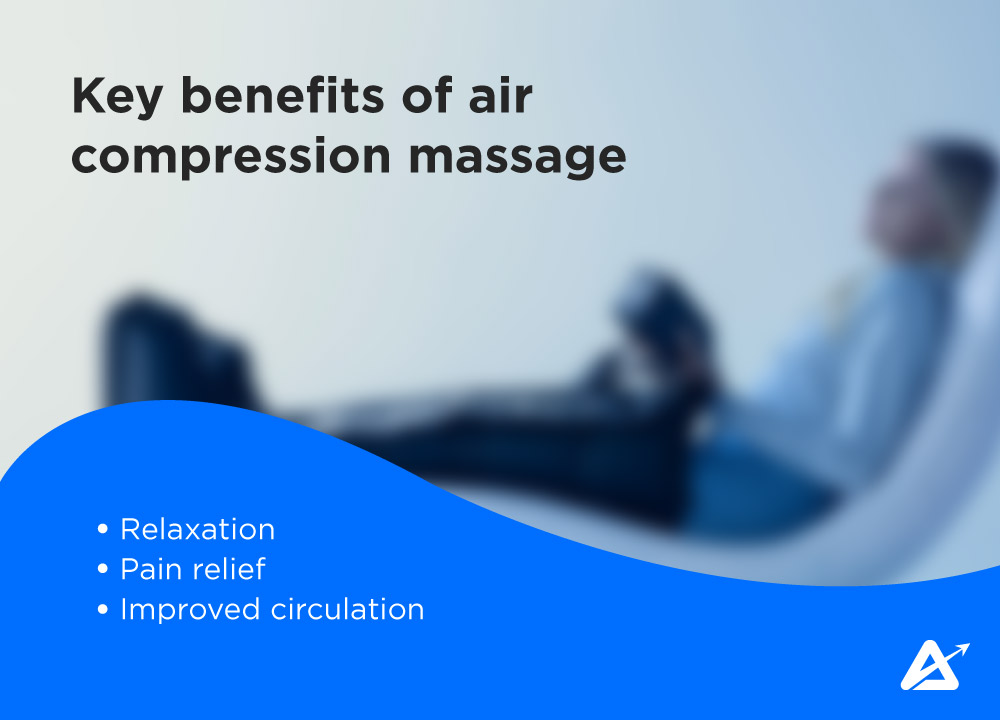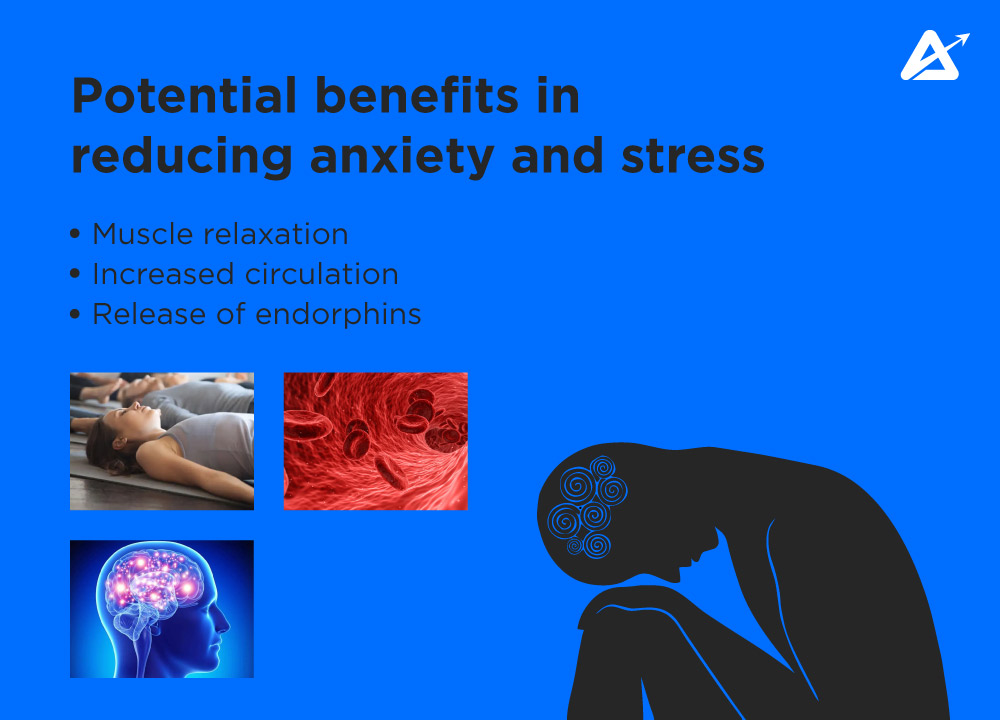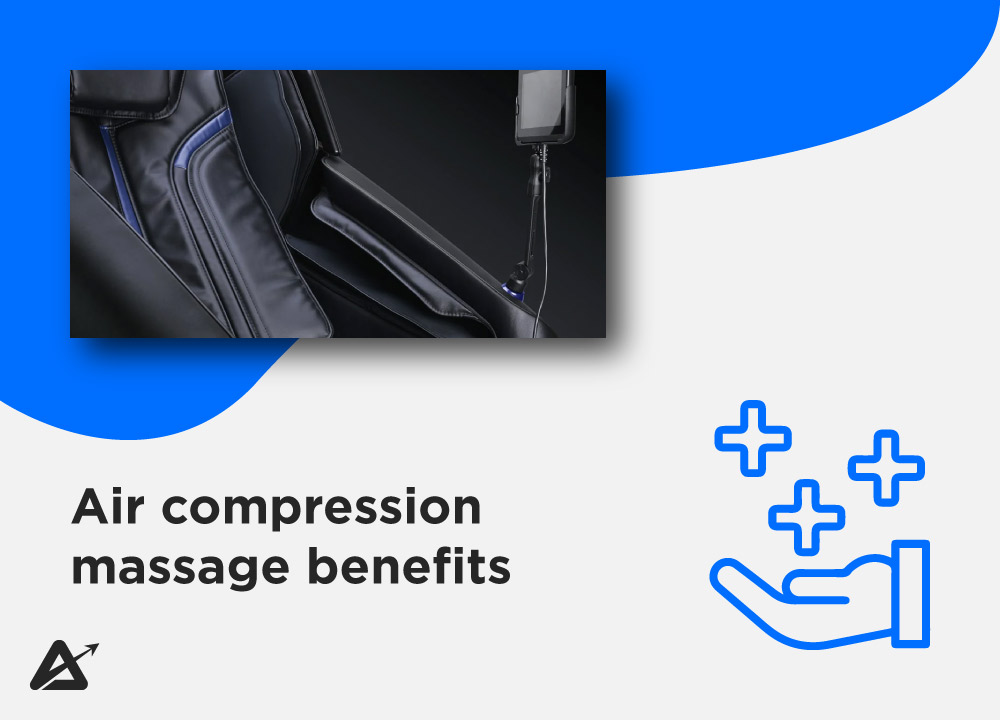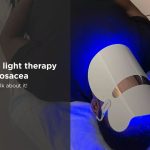In today’s fast-paced world, finding effective ways to relax and rejuvenate is crucial for maintaining our overall well-being. One such method gaining popularity is air compression massage. Air compression massage benefits include improved circulation, reduced muscle soreness, relaxation, and relief from pain and tension.
Air compression massage, also known as pneumatic or sequential compression therapy, involves the use of inflatable cuffs or sleeves that rhythmically inflate and deflate, applying pressure to different parts of the body.
This blog aims to delve into the wonderful benefits that air compression massage can offer, both physically and mentally.
What Is Air Compression Massage?
Air compression massage is a therapeutic technique that utilizes controlled air pressure to provide a soothing and invigorating massage experience. It involves the use of specially designed devices or chairs that apply rhythmic and sequential air pressure to different parts of the body.
The compression sleeves or chambers inflate and deflate, mimicking the movements of a skilled massage therapist’s hands. This type of massage promotes blood circulation, reduces muscle tension, and enhances relaxation. It is commonly used for relieving muscle soreness, improving lymphatic flow, and providing overall rejuvenation and stress relief.
We have already discussed how to use the facial massage tool. If you are not aware of this then you can read our blog carefully – where we will know the use of facial massage tool and their pros and cons.
What is air compression massage good for?
Air compression massage, also known as pneumatic or compression therapy, is beneficial for various reasons. It improves blood circulation, reduces muscle soreness, and promotes relaxation. By applying rhythmic pressure through air-filled chambers, it stimulates the lymphatic system, aiding in detoxification and reducing edema.
Air compression massage is effective in alleviating muscle tension, relieving joint pain, and reducing the appearance of cellulite. Additionally, it can enhance post-workout recovery, decrease stress levels, and provide relief from symptoms associated with conditions like poor circulation, fibromyalgia, and restless legs syndrome.
Air Compression Massage Benefits

Air compression massage benefits offer a range of benefits, including relaxation, pain relief, improved circulation, enhanced recovery, and limb relaxation. Whether used for therapeutic purposes or as a luxurious treat, this technique can contribute to overall well-being and physical comfort. Here are some key benefits of air compression massage:
- Relaxation: The gentle and rhythmic squeezing action of the air compression sleeves promotes deep relaxation, reducing muscle tension and alleviating stress.
- Pain relief: The targeted pressure exerted by the sleeves helps relieve muscle soreness, joint pain, and discomfort caused by conditions like arthritis. It can also be beneficial for individuals recovering from injuries or surgery.
- Improved circulation: By enhancing blood flow and lymphatic drainage, air compression massage stimulates the delivery of oxygen and nutrients to tissues while facilitating the removal of waste products. This can aid in reducing swelling, edema, and cellulite.
- Enhanced recovery: The increased circulation and lymphatic flow provided by air compression massage helps speed up the recovery process by reducing inflammation, promoting tissue repair, and flushing out metabolic byproducts.
- Relaxation of limbs: Sequential compression of the limbs aids in reducing swelling and promoting venous return, making it particularly beneficial for individuals with circulatory issues or those who spend long periods sitting or standing.
What is the function of air compression?
Air compression serves various functions across multiple industries. Its primary purpose is to increase the pressure and density of air for practical applications. Key functions of air compression include:
- Power Generation: Compressed air is used to drive turbines, generating electrical power.
- Industrial Processes: These power pneumatic tools, equipment, and machinery in manufacturing and construction.
- Transportation: Compressed air supports brakes, suspensions, and airbags in vehicles and aircraft.
- Refrigeration and HVAC: It enables efficient cooling and climate control systems.
- Medical Applications: Compressed air is utilized in breathing apparatus, dental tools, and surgical equipment.
- Scuba Diving: It supplies breathing air to divers exploring underwater environments.
- Cleaning and Painting: Compressed air propels cleaning jets and paint sprayers.
- Packaging: It helps seal containers and inflate packaging materials.
- Waste Treatment: Air compression aids in wastewater treatment and aeration processes.
- Research and Testing: Compressed air is used in laboratories for various scientific experiments.
These functions highlight the versatility and importance of air compression in a wide range of industries and applications.
How long should you use an air-compression leg massager?
The duration of using an air-compression leg massager may vary depending on individual preferences and needs. Generally, a session of 15 to 30 minutes is considered sufficient to experience the benefits of the device.
It is recommended to start with shorter sessions and gradually increase the time as you become more comfortable and accustomed to the sensation. However, it is essential to listen to your body and avoid prolonged use that may lead to discomfort or overstimulation.
It is always advisable to follow the manufacturer’s instructions and consult with a healthcare professional if you have any specific concerns or medical conditions.
Using Air Compression Massage to Increase Blood Circulation
Air compression massage utilizes alternating air pressure to stimulate blood circulation. The therapy involves specialized devices that apply controlled compression to different areas of the body, such as the limbs or waist.
As the air chambers inflate and deflate, they exert gentle pressure on the targeted regions, promoting blood flow and lymphatic drainage. This technique aids in reducing muscle tension, relieving pain, and alleviating swelling.
By enhancing circulation, air compression massage facilitates nutrient and oxygen delivery to tissues while facilitating the removal of metabolic waste, contributing to overall well-being.
Correlation Between Air Compression Massage and Pain Relief
Air compression massage has shown a promising correlation with pain relief. This therapeutic technique involves applying rhythmic pressure to specific areas using compressed air.
The compression promotes blood flow and stimulates the release of endorphins, the body’s natural painkillers. By targeting muscle tension and increasing circulation, air compression massage can alleviate various types of pain, such as muscle soreness, joint discomfort, and even headaches.
This correlation suggests that air compression massage can be an effective non-invasive approach for pain management and relaxation.
Air Compression Massage Enhances How the Body Heals Itself
Air compression massage has been shown to enhance the body’s natural healing process. By applying rhythmic pressure to specific areas, it promotes blood circulation and lymphatic flow, accelerating the removal of toxins and waste products.
This increased circulation delivers vital nutrients and oxygen to tissues, aiding in their repair and regeneration. Additionally, gentle stretching and relaxation of muscles and fascia promote pain relief and reduce inflammation.
Overall, air compression massage serves as a non-invasive method to support and optimize the body’s innate healing abilities.
Potential Air Compression Massage Benefits for Anxiety and Stress

Air compression massage has been recognized for its potential benefits in reducing anxiety and stress. Here are some key points regarding its advantages:
- Muscle relaxation: Air compression massage targets specific muscle groups, promoting relaxation and relieving tension. This physical relief can help alleviate the symptoms of anxiety and stress.
- Increased circulation: The compression action stimulates blood flow, enhancing circulation throughout the body. Improved blood flow delivers oxygen and nutrients while removing toxins, promoting a sense of calm and reducing stress levels.
- Release of endorphins: Air compression massage triggers the release of endorphins, the body’s natural “feel-good” hormones. These endorphins help reduce anxiety and create a sense of overall well-being.
- Enhanced sleep quality: By promoting relaxation and reducing stress, air compression massage can improve sleep quality. A good night’s sleep is crucial for managing anxiety and stress levels.
- Overall relaxation response: The rhythmic compression and decompression of air massage provide a soothing and calming effect on the body and mind. This relaxation response aids in reducing anxiety and stress and can contribute to a sense of tranquility.
While air compression massage can be a valuable addition to anxiety and stress management strategies, it is important to consult a healthcare professional for personalized advice and treatment options.
In conclusion
Air compression massage offers numerous benefits for individuals seeking relaxation, pain relief, and improved overall well-being. The technique involves the use of air pressure to apply rhythmic compressions to different parts of the body, creating a gentle and soothing massage experience.






